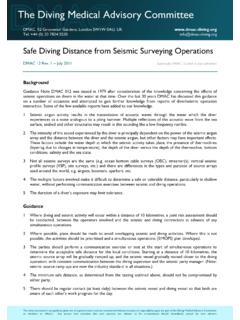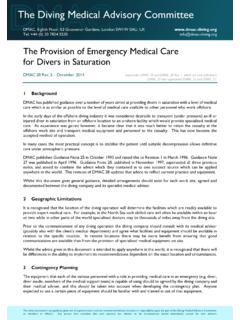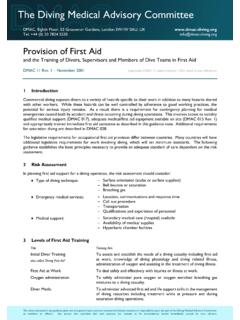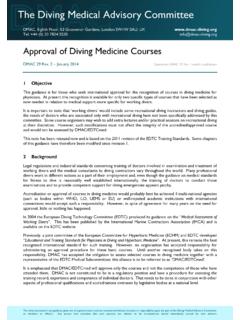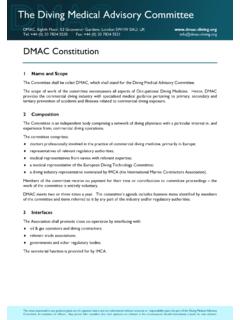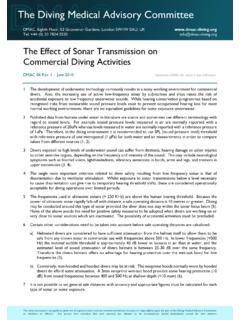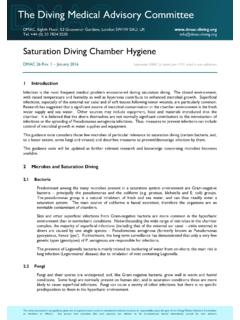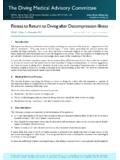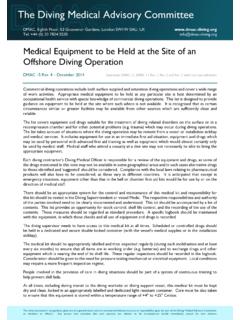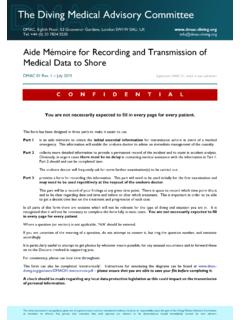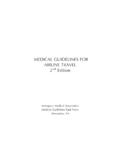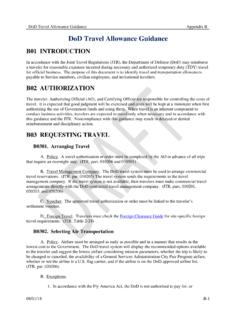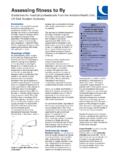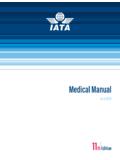Transcription of The Diving Medical Advisory Committee
1 The Diving Medical Advisory Committee DMAC, Eighth Floor, 52 Grosvenor Gardens, London SW1W 0AU, UK Tel: +44 (0) 20 7824 5520 The views expressed in any guidance given are of a general nature and are volunteered without recourse or responsibility upon the part of the Diving Medical Advisory Committee , its members or officers. Any person who considers that such opinions are relevant to his circumstances should immediately consult his own advisers. Flying after Diving : Recommendations DMAC 07 Rev. 2 November 2017 Supersedes DMAC 07 Rev. 1, which is now withdrawn Introduction This guidance note was first published in 1982.
2 Since then it has been reviewed in 1996 and revised in 2001. This review takes into account evidence from a number of scientific investigations conducted since the last review and clinical experience. The times recommended have never been tested and in commercial Diving the interval between Diving and flying is commonly longer than that recommended in the guidelines. In most situations flying involves exposure to reduced barometric pressure (altitude). After Diving , exposure to altitude always carries a risk from decompression illness (DCI), in particular if the diver has any symptoms (see later).
3 This together with our evaluation of the existing experimental evidence and experience is the basis of the revised recommendations. Unfortunately there is no evidence relating to repeated exposure to altitude. For the purposes of these guidelines, it was considered that Diving could be divided into two categories: 1. Air and nitrox Diving ; 2. Mixed gas Diving . Two maximum cabin altitudes were considered, viz: a) A maximum altitude of 2000 (600m), provided that the flight plan has been checked consistent with a helicopter flight from an offshore platform or vessel; b) A maximum altitude of 8000 (2400m) all other flights.
4 2400m is widely used as the maximum cabin altitude in commercial passenger flights. Caution The times given below are minimum times: longer time intervals are recommended, in particular if the planned journey involves a number of take-offs. Journeys involving multiple flights are common and are likely to carry an increased risk. Shorter times may be considered but only after the advice of a qualified Medical Diving physician. Flying (or any altitude exposure including road travel) in the presence of even minor symptoms of decompression illness carries a considerable risk of provoking serious neurological illness.
5 Page 2 November 2017 DMAC 07 Rev. 2 1 Diving without decompression illness problems or any symptoms Minimum times before flying at cabin altitude 2000 (600m) All other flights No Stop dives Total time under pressure less than 60 minutes within the last 12 hours 2 hours 18 hours (24 hours)* All other air and nitrox Diving , heliox and mixed gas bounce Diving (less than 4 hours under pressure) 12 hours 24 hours Heliox saturation (more than 4 hours under pressure) Air, nitrox or trimix saturation (more than 4 hours under pressure) 24 hours 48 hours * 18 hour time applies to short flights (less than 3 hours).
6 For longer flights the time is extended to 24 hours 2 Following therapy for DCI, advice must be sought from a Diving Medical specialist Minimum time from completion of therapy (completion of recompression treatment) 2000 (600m) All other flights Immediate and complete resolution of symptoms on first recompression 24 hours 72 hours Cases without immediate response or with residual symptoms must be decided on an individual basis by a Diving Medical specialist. Generally wait as long as practical Consult a Diving Medical specialist Residual risks will be reduced by giving 100% oxygen during the flight.
7 Following landing the diver should be assessed by a Diving Medical specialist. 3 DCI in Flight In most circumstances, the Medical decisions concerning an air passenger who develops symptoms of decompression illness during flight will be the responsibility of the air crew and airline. The following guidance may be helpful. Where the diver s symptoms consist only of pain in a limb, the diver should be treated with analgesics, oral fluids, and oxygen if available. Advice should be sought from a Diving Medical specialist. It may be possible for the plane to continue to its destination without diversion or adjustment of altitude, but the risk of development of more serious symptoms, duration of flight and route need to be considered.
8 When the diver has any other symptoms, immediate advice should be sought from a Diving Medical specialist. The diver should be given 100% oxygen and oral fluids. Reduction in cabin altitude and diversion to an airport where further treatment can be given may be necessary.
